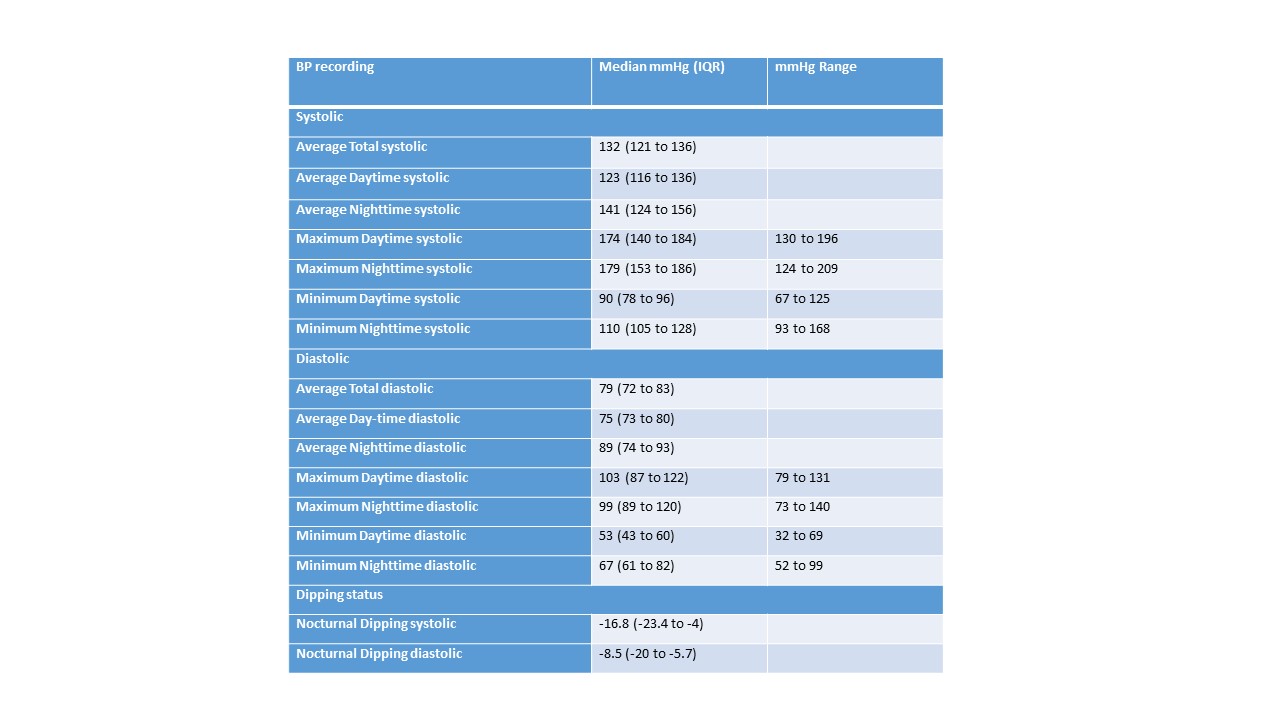Objective: To describe prevalence and severity of nocturnal hypertension and dipping in a cohort of patients with Parkinson’s disease undergoing 24hr blood pressure (BP) monitoring.
Background: Nocturnal hypertension has a reported prevalence of 39% in Parkinson’s disease1. Despite this prevalence, very little attention is paid to it or its management. Indeed, a recent systematic review concludes “the effect of blood pressure control and the risk of death from cardiovascular disease in Parkinson’s disease are largely unexplored”2. Reviews of BP management in Parkinson’s disease often fail to mention nocturnal hypertension, instead focusing their attention on orthostatic hypotension, neglecting the bidirectional relationship between the two2.
Method: Sequential patients who undertook 24hr BP monitoring were recruited from a single clinic. Age, sex, Hoen and Yahr, medications and indication for 24hr BP monitoring were recorded. We assessed 24hr blood pressure parameters including average overall, day time and nighttime BP; nocturnal dipping status; and minimum and maximum daytime and nocturnal BP measurements.
Results: 18 patients underwent 24hr BP monitoring. The mean age was 74 (SD 5) and 35% were female. Mean disease duration was 9 years (SD 8). Median Hoen and Yahr was 2 (IQR 2 to 3). 41% of patients were on antihypertensives, 24% were on treatment for orthostatic hypotension. All patients were on dopaminergic treatment, 33% being on long-acting medications overnight. The indication for 24hr BP monitoring was suspicion of postural or medication related hypotension in all patients. BP measurements are recorded in table 1. Median nocturnal BP readings were significantly higher than daytime readings (p=0.003), as high as 209mmHg in one patient. The median peak systolic and diastolic BP readings overnight were 179mmHg and 99mmHg respectively. 85% of patients showed reverse nocturnal dipping. The median percentage of time spent in the hypertensive range overnight was 90% for systolic pressures (IQR 29 to 100) and 80% (IQR 20 to 100) for diastolic pressures. The median daytime minimum systolic pressure was 90mmHg (IQR 78 to 96).
Conclusion: We show in a cohort of patients with relatively mild Parkinson’s disease that nocturnal hypertension is not only prevalent but nocturnal BP readings are concerningly high and warrant consideration of specific treatment. Urgent attention is required to address this issue.
Table 1
References: 1. Tulba D, Cozma L, Balanescu P, Buzea A, Baicus C, Popescu BO. Blood Pressure Patterns in Patients with Parkinson’s Disease: A Systematic Review. J Pers Med. Feb 15 2021;11(2)doi:10.3390/jpm11020129
2. Katsi V, Papakonstantinou I, Solomou E, Antonopoulos AS, Vlachopoulos C, Tsioufis K. Management of Hypertension and Blood Pressure Dysregulation in Patients with Parkinson’s Disease-a Systematic Review. Curr Hypertens Rep. May 7 2021;23(5):26. doi:10.1007/s11906-021-01146-5
To cite this abstract in AMA style:
D. Wilson, M. Hagens, S. Nagaratnam, V. Fung. Nocturnal Hypertension in Parkinson’s Disease. The Flip Side of a Tainted Coin [abstract]. Mov Disord. 2024; 39 (suppl 1). https://www.mdsabstracts.org/abstract/nocturnal-hypertension-in-parkinsons-disease-the-flip-side-of-a-tainted-coin/. Accessed December 30, 2025.« Back to 2024 International Congress
MDS Abstracts - https://www.mdsabstracts.org/abstract/nocturnal-hypertension-in-parkinsons-disease-the-flip-side-of-a-tainted-coin/

